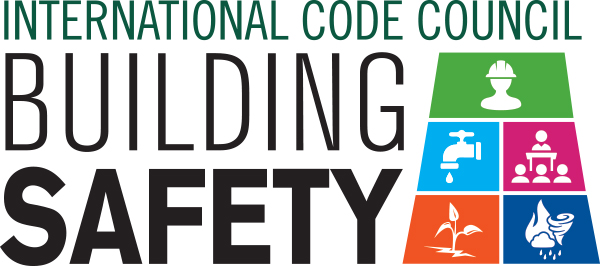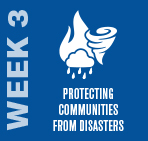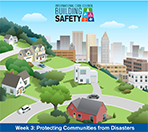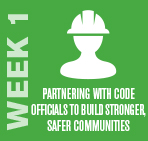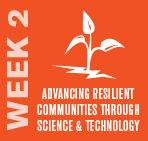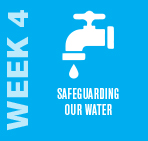
Week THREE // May 13-19, 2018
Protecting Communities from Disasters
WEEK THREE // May 13-19, 2018
Build to Code
Although you have little control over the occurrence of natural disasters in your community, mitigation efforts are some of the best tactics jurisdictions can take to protect a community against the effects of these disasters. Mitigation increases occupant health and safety during a disaster, protects the local tax base, ensures continuity of essential services, and supports more rapid recovery from disasters. Mitigation through adoption and enforcement of building codes provide you, your family and your community protection in the event of a natural disaster.
The development and widespread adoption of building codes creates a uniform regulatory environment in which design professionals and contractors are held to a set of standards adopted by and applicable to the jurisdiction in which they work. Building regulation in the United States began in the late 1800s when major cities began to adopt and enforce building codes in response to large fires in densely populated urban areas. Over time, the scope of building codes broadened. Today, building codes address structural integrity, lighting, ventilation, safe egress, construction materials as well as fire resistance. They specify the minimum requirements to safeguard the health, safety and general welfare of building occupants.
To learn more about building codes, check out the Code Council's Introduction to Building Codes and FEMAs Building Codes Toolkit.
Prepare Your Family
Making sure your family is prepared for any natural disaster is important. Below are some of the steps you can take to prepare your family and protect your home from natural disasters. Your actions can ensure that no matter what Mother Nature brings, you, your family and your community will be resilient.
Here are a few tips to follow from the Federal Alliance for Safe Homes – (FLASH®) when preparing your family for any emergency.
- Develop a family disaster plan that includes a list of food and water supplies needed for each member of your family and supplies for your pets. Make copies of important documents like insurance policies, the deed to your home, and other personal papers, important phone numbers and a home inventory. Create a checklist of important things to do before, during and after a disaster.
- Review your evacuation route and emergency shelter locations with your family. Options for evacuation would include staying with friends and relatives, seeking commercial lodging or staying in a mass care facility operated by disaster relief groups in conjunction with local authorities.
- Taking shelter is critical in times of disaster. Sheltering in place is appropriate when conditions require that you seek protection in your home, place of employment or other location where you are when disaster strikes.
- Consider incorporating a safe room in building plans and improvements.
- Review your plan regularly. If you make changes that affect the information in your disaster plan, update it immediately.
Visit America’s PrepareAthon! to learn more about how to prepare for earthquakes, floods, hurricanes, tornadoes, wildfires and winter storms. Get Involved to help prepare your family and community.
Protect Your Home
The power of natural disasters can be overwhelming. While you can't necessarily stop them from happening, there are steps you can take to increase your home's chance of survival, even in the face of the worst that Mother Nature can dish out.
Flood insurance can be the difference between recovering and being financially devastated. Just one inch of water in a home can cost more than $25,000 in damages. The average flood insurance claims payment to homeowners was about $90,000 from the Baton Rouge floods in 2016 and $65,000 for Superstorm Sandy that struck the Northeast in 2012. FEMA's Individual Assistance Program can provide financial assistance for home repairs, rental assistance, and other needs, but the average payouts are much smaller, on the order of $6,000 to $8,000 per household — why risk it?
The International Codes (I-Codes), developed by the International Code Council, are a family of fifteen coordinated, modern building safety codes used in all 50 U.S. states and in many other countries that protect against disasters like fires, weather-related events and structural collapse. Documents summarizing the hazard-resistant provisions of the International Codes are available at FEMA’s Building Code Resources page. This page also includes other guidance documents on codes and standards.
ICC's Pulse Podcast: Episode 3--FEMA and Pre-disaster Mitgation
This episode of our monthly Pulse Podcast featured two guests from the Federal Insurance and Mitigation Administration (FIMA) of the Federal Emergency Management Agency (FEMA). John Ingargiola, Lead Physical Scientist of FEMA’s Building Science Branch, and Eric Letvin, FEMA’s Deputy Assistant Administrator of Mitigation, joined us to discuss pre-disaster mitigation, a prevalent topic after the series of tragic natural disasters in 2017.
To read more, click here.
Disaster Information and Resources
Flood Clean Up Safety & Salvaging brochure
Role-playing game: Is Your Community Ready for an Extreme Event?
Safety First--Disaster Preparedness: Tips for Your Home and Family Brochure

